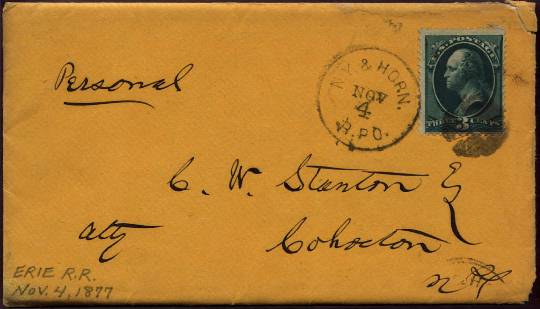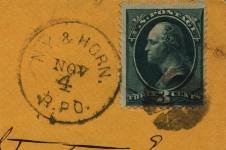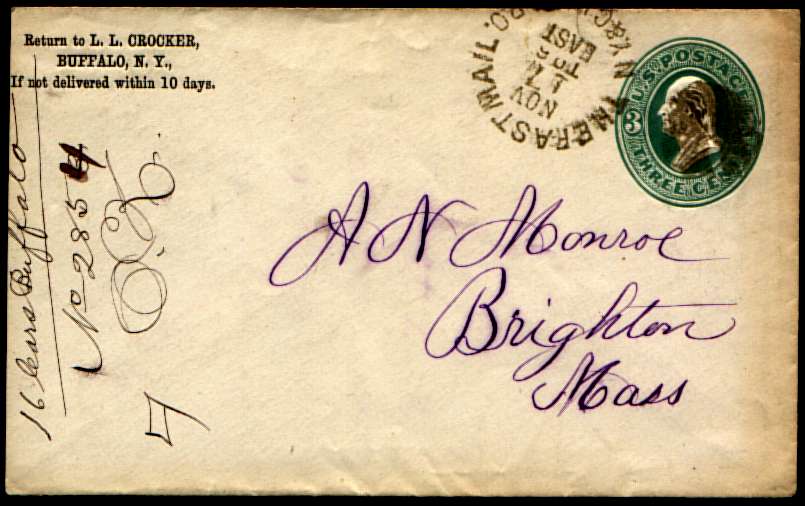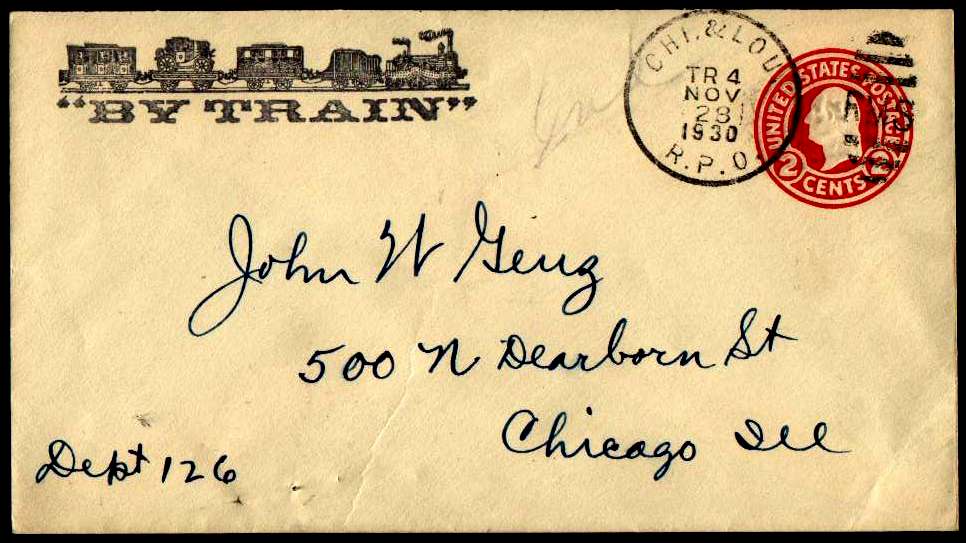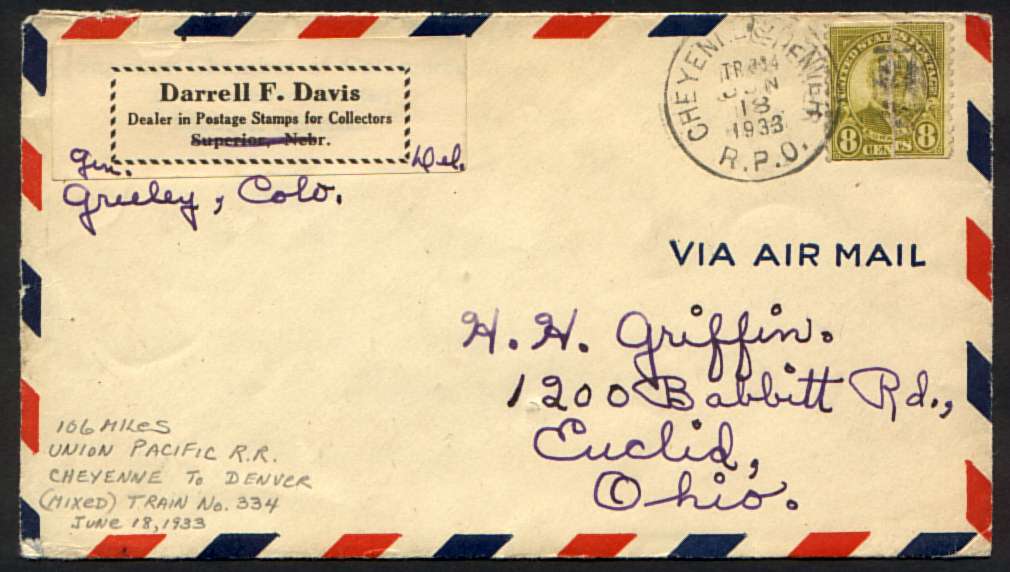

R is for RPO - Page 2 |

|

|

|

|
Early RPOs
One major ditiinction between forerunner markings like Route Agents and the true RPO postmarks is that the Agent markings state the name of the railroad that owned the train the item was processed on, while RPO's state the route the train was traveling, so one cannot tell the name of the railroad from the RPO markings. Collectors often mark their RPO covers with the name of the railroad to correct this deficiency, though as I say below, I deplore the practice. If you must write on a cover, do it on the back at least! Note that most covers from here on do not have a "Towle number", since his main work covers only the Route and Station Agents. There are a few exceptions, where he numbered RPO markings in an earlier work.
The Railway Mail Service was inaugurated in preliminary form in 1864, so if the notation
on it is correct, this cover dates from the 13th year of RPO's. What collectors pursue
are the postmarks, as you might guess from the pencil notation someone added to this
cover. PLEASE do not write on your covers! No matter how little you paid, any value it
has, monetarily or simply as a collectible item, is seriously diminished by any added
text or markings. It should be kept in a plastic sleeve, anyway, so you can stick all
the labels you want on that, and write to your heart's content.
THE FAST MAIL
The original Fast Mail (the name was used again later for other, similar trains), inaugurated September 16, 1875, was the first express mail train in the US, running on the route from New York to Chicago in record time - it completed its first run in only twenty-six hours, half the previous time! Congressional penury over fees for transporting mail led to the cancellation of the service on July 22, 1876. These two envelopes (both are Scott U163, issued in 1874) may date from the ten months between those dates. (Towle pictures six versions of this postmark, numbered 114-J-1 through 114-J-5, and 115-L-1, in RAILROAD POSTMARKS of the UNITED STATES, 1861 to 1886, coauthored with Henry A Meyer, pub. The U.S. Philatelics Classics Society, 1968.)
Later RPOs

This is one of my favorite RPO covers, since not only does it have a nice clear RPO cancel, it is also franked with Scott 295, one of my favorite train stamps, AND it has that great illustration, with a train! Note the "W.D." in the postmark, and the "E.D." in the one on the left below, which may help you guess their meaning - Eastbound Direction vs. Westbound Direction, I think, though the "D" may be for "Division". Any experts out there care to enlighten me?
April 7, 2002 - THIS JUST IN - Norm Wright, Sr., editor of the ATA World Railways Philatelic Handbook, as well as editor of the New Issues Listing of the Casey Jones Rail Road Unit newlsetter (The Dispatcher), just sent tis note:
Stay tuned for more.On the New York Central -- N.Y. to Chicago RPOs, these initials stood for Eastern Division and Western Division; there was also a Central Divsion (Buffalo - Syracuse).
The direction of the train was determined by the Train No., with even numbers on eastbound trains and odd numbers on westbound trains.
I don't know if this was universal, or just NYC. However, a little research in an older "Official Guide" would probably answer that.

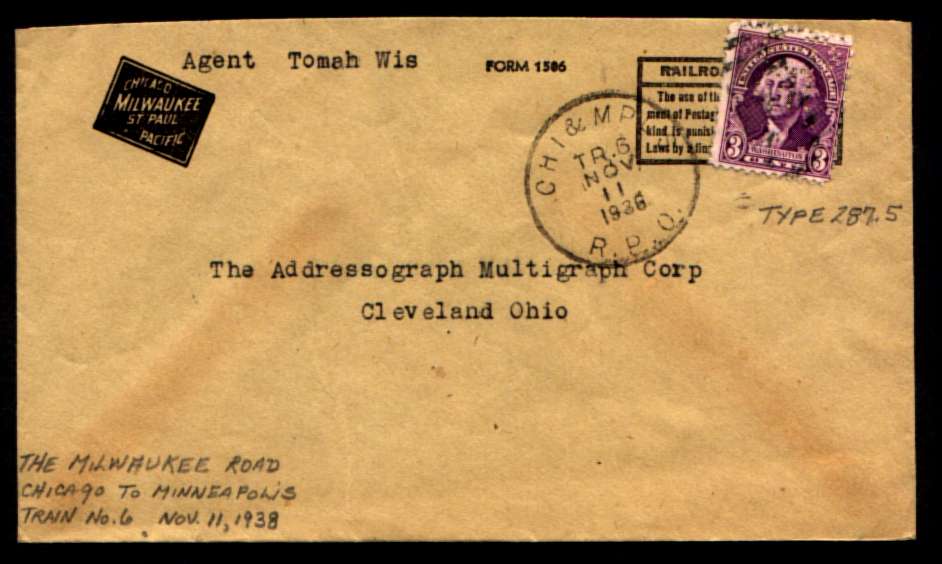
These two RPO covers share another railroad tie-in: they are both from railway
companies. Once again - please do not write on covers!
This one's appeal is obvious, if you love trains as I do, but it also poses a bit of a mystery, as I want to know who the sender was, and why he had that corner card created but did not include his identity. It looks like it could even be a rubber stamp, rather than a printed design. "Dept 126 at 500 N Dearborn St" looks like a business address, so my guess now is that this is mail internal to a railroad.
CAUGHT RED-HANDED
The added attraction of this Cheyenne & Denver RPO cover is the carbon copy of a letter inside, which reads as follows:
Dear Sir:
In sending the last lot of Precancels to me, I notice that you franked the envelope with what looked like a mutilated eight cent stamp; the postman mentioned the matter to me and I am drawing it to your attention as the P.O. Dept. may wish to investigate the matter.
I think the writer was being tactful, as the stamp halves on the cover are quite obviously not from the same stamp. Yet the cover survived, so presumably the postal inspectors did not show up to claim it. Was Mr. Griffin really trying to be helpful, or was he saying "I'm on to you, you crook?" What puzzles me, though, is why anyone who was attempting to defraud the POD would do such a crude job of it.
| Home | R - Page 1 <<< | Contents | >>>R - Page 3 | Credits |
All Letter images Copyright © 1997, 2000, SF chapter of AIGA
All text Copyright © 2000, William M. Senkus
Send feedback to the webmaster: CLICK HERE
Revised -- 07/01/2004
